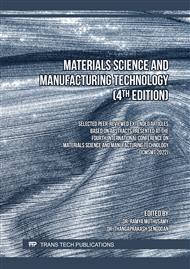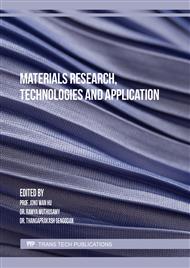[1]
Pıhtılı Hasim and Tosun Nihat, Investigation of the wear behaviour of a glass-fiber-reinforced composite and plain polyester resin,, Compos. Sci. Technol., vol. 62, p.367–370, (2002).
DOI: 10.1016/s0266-3538(01)00196-8
Google Scholar
[2]
B. Suresha, G. Chandramohan, Siddaramaiah, P. Samapthkumaran, and S. Seetharamu, Three-body abrasive wear behaviour of carbon and glass fiber reinforced epoxy composites,, Mater. Sci. Eng. A, vol. 443, no. 1–2, p.285–291, 2007,.
DOI: 10.1016/j.msea.2006.09.016
Google Scholar
[3]
S. S. Mahapatra and A. Patnaik, Study on mechanical and erosion wear behavior of hybrid composites using Taguchi experimental design,, Mater. Des., vol. 30, no. 8, p.2791–2801, 2009,.
DOI: 10.1016/j.matdes.2009.01.037
Google Scholar
[4]
S. Chauhan, A. Kumar, A. Patnaik, A. Satapathy, and I. Singh, Mechanical and wear characterization of gf reinforced vinyl ester resin composites with different co-monomers,, J. Reinf. Plast. Compos., vol. 28, no. 21, p.2675–2684, 2009, doi:10.1177/ 0731684408093823.
DOI: 10.1177/0731684408093823
Google Scholar
[5]
E. Lackey, J. G. Vaughan, K. Inamdar, and B. Hancock, Statistical characterization of pultruded composites with natural fiber reinforcements - Part A: Fabrication,, J. Nat. Fibers, vol. 4, no. 4, p.73–87, 2007,.
DOI: 10.1080/15440470801894057
Google Scholar
[6]
D. N. Saheb and J. P. Jog, 0Deec52E7C9B24B713000000.Pdf,, J. Adv. Polym. Technol., vol. 18, no. 4, p.351–363, 1999, [Online]. Available: https://www.researchgate.net/ profile/Jyoti_Jog/publication/227941520_Natural_fiber_polymer_composites_A_Review/links/0deec52e7c9b24b713000000.pdf.
DOI: 10.1002/(sici)1098-2329(199924)18:4<351::aid-adv6>3.0.co;2-x
Google Scholar
[7]
X. Li, L. G. Tabil, and S. Panigrahi, Chemical Treatments of Natural Fiber for Use in Natural Fiber-Reinforced Composites: A Review,, J. Polym. Environ., vol. 15, no. 1, p.25–33, Feb. 2007,.
DOI: 10.1007/s10924-006-0042-3
Google Scholar
[8]
K. Jarukumjorn and N. Suppakarn, Effect of glass fiber hybridization on properties of sisal fiber-polypropylene composites,, Compos. Part B Eng., vol. 40, no. 7, p.623–627, 2009,.
DOI: 10.1016/j.compositesb.2009.04.007
Google Scholar
[9]
F. de A. Silva, R. D. T. Filho, J. de A. M. Filho, and E. de M. R. Fairbairn, Physical and mechanical properties of durable sisal fiber-cement composites,, Constr. Build. Mater., vol. 24, no. 5, p.777–785, 2010,.
DOI: 10.1016/j.conbuildmat.2009.10.030
Google Scholar
[10]
M. Ramesh, K. Palanikumar, and K. H. Reddy, Comparative evaluation on properties of hybrid glass fiber-sisal/jute reinforced epoxy composites,, Procedia Eng., vol. 51, no. NUiCONE 2012, p.745–750, 2013,.
DOI: 10.1016/j.proeng.2013.01.106
Google Scholar
[11]
R. Gujjala, S. Ojha, S. K. Acharya, and S. K. Pal, Mechanical properties of woven jute-glass hybrid-reinforced epoxy composite,, J. Compos. Mater., vol. 48, no. 28, p.3445–3455, 2014,.
DOI: 10.1177/0021998313501924
Google Scholar
[12]
G. Raghavendra, Mechanical and Tribological Behavior of Nanofiller Reinforced Polymer a Thesis Submitted in Partial Fulfilment of Mechanical and Tribological Behavior of Nanofiller Reinforced Polymer a Thesis Submitted in Partial Fulfilment of,, (2014).
Google Scholar
[13]
R. Rahman and S. Zhafer Firdaus Syed Putra, Tensile properties of natural and synthetic fiber-reinforced polymer composites,, in Mechanical and Physical Testing of Biocomposites, Fibre-Reinforced Composites and Hybrid Composites, Elsevier, 2019, p.81–102.
DOI: 10.1016/b978-0-08-102292-4.00005-9
Google Scholar
[14]
M. M. Davoodi, S. M. Sapuan, D. Ahmad, A. Ali, A. Khalina, and M. Jonoobi, Mechanical properties of hybrid kenaf/glass reinforced epoxy composite for passenger car bumper beam,, Mater. Des., vol. 31, no. 10, p.4927–4932, 2010,.
DOI: 10.1016/j.matdes.2010.05.021
Google Scholar
[15]
P. Noorunnisa Khanam, M. Mohan Reddy, K. Raghu, K. John, and S. Venkata Naidu, Tensile, flexural and compressive properties of sisal/silk hybrid composites,, J. Reinf. Plast. Compos., vol. 26, no. 10, p.1065–1070, 2007,.
DOI: 10.1177/0731684407079347
Google Scholar
[16]
S. Mishra et al., Studies on mechanical performance of biofibre/glass reinforced polyester hybrid composites,, Compos. Sci. Technol., vol. 63, no. 10, p.1377–1385, 2003,.
DOI: 10.1016/s0266-3538(03)00084-8
Google Scholar
[17]
C. Pavithran, P. S. Mukherjee, and M. Brahmakumar, Coir-Glass Intermingled Fibre Hybrid Composites,, J. Reinf. Plast. Compos., vol. 10, no. 1, p.91–101, 1991,.
DOI: 10.1177/073168449101000106
Google Scholar
[18]
Mohan And Kishore, Jute and Glass Sandwich, vol. 4, no. April, p.186–194, (1985).
Google Scholar
[19]
kalaprasad, from the SAGE Social Science Collections. All Rights,, Hisp. J. Behav. Sci., vol. 9, no. 2, p.183–205, 2001, [Online]. Available: http://hjb.sagepub.com.proxy. lib.umich.edu/ content/ 9/2/183.full.pdf+html.
Google Scholar
[20]
G. Marom, S. Fischer, F. R. Tuler, and H. D. Wagner, Hybrid effects in composites: conditions for positive or negative effects versus rule-of-mixtures behaviour,, J. Mater. Sci., vol. 13, no. 7, p.1419–1426, 1978,.
DOI: 10.1007/bf00553194
Google Scholar
[21]
M. M. Thwe and K. Liao, Characterization of bamboo-glass fiber reinforced polymer matrix hybrid composite,, J. Mater. Sci. Lett., vol. 19, no. 20, p.1873–1876, 2000,.
Google Scholar
[22]
R. Bhoopathi, C. Deepa, G. Sasikala, and M. Ramesh, Experimental Investigation on Mechanical Properties of Hemp-Banana-Glass Fiber Reinforced Composites,, Appl. Mech. Mater., vol. 766–767, no. June 2015, p.167–172, 2015,.
DOI: 10.4028/www.scientific.net/amm.766-767.167
Google Scholar
[23]
M. A. Al-Shammari, Experimental and Numerical Investigation of Hyper Composite Plate Structure Under Thermal and Mechanical Loadings,, Univ. Baghdad Eng. J., vol. 23, no. 8, p.56–69, 2017, [Online]. Available: https://www.researchgate.net/publication/ 319653469_Experimental_and_Numerical_Investigation_of_Hyper_Composite_Plate_Structure_Under_Thermal_and_Mechanical_Loadings.
Google Scholar
[24]
Y. Basavaraj and H. Raghavendra, Experimental and Numerical Study of the Influence of Volume Fraction on Tensile and Flexural Strength of E-Glass Epoxy Cross Ply Laminates,, Int. J. Mech. Ind. Technol., vol. 2, no. 1, p.39–44, (2014).
Google Scholar
[25]
I. S. Aji, E. S. Zainudin, S. M. Sapuan, A. Khalina, and M. D. Khairul, Study of Hybridized Kenaf/PALF-Reinforced HDPE Composites by Dynamic Mechanical Analysis,, Polym. - Plast. Technol. Eng., 2012,.
DOI: 10.1080/03602559.2011.618166
Google Scholar
[26]
A. Konyukhov, Modelling of cutting with arbitrary kinematics. Special study of contact algorithms,, no. July, p.108, 2018,.
Google Scholar
[27]
R. E. Izzaty, B. Astuti, and N. Cholimah, NOTCHED BAR TEST,, Angew. Chemie Int. Ed. 6(11), 951–952., p.5–24, (1967).
Google Scholar



